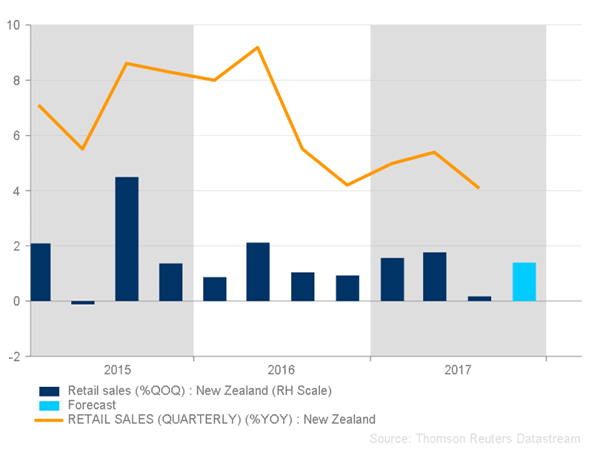New Zealand retail sales data for the fourth quarter of 2017 are due for release at 2145 GMT on Thursday, with forecasts pointing to a strong rise in quarterly terms. The indicator is expected to edge up by 1.4% in the three months to December, following a rise of 0.2% before.
The latest release was the slowest gain since June 2015, mainly explained by weaknesses in housing construction and in food and beverage services. Also, the attention will turn on the kiwi as there is plenty of room for a surprise if the release beats expectations.

Turning to monetary policy, the Reserve Bank of New Zealand (RBNZ) announced its official cash rate on February 7 and kept it at a record low of 1.75%, as widely expected. The central bank last changed the key rate in November 2016. Also, policymakers mentioned that the global economy has continued to improve and recognized that inflation remains subdued. The policy statement highlighted some signs of emerging pressures, namely, an increase in commodity prices, strong equity markets, and less stimulatory monetary policy.
In addition, the RBNZ stated that monetary policy will remain accommodative for a considerable period, as numerous uncertainties remain, and policy may need to adjust accordingly. It is worth mentioning that the nation’s consumer prices increased by 1.6% year-on-year in the fourth quarter from 1.9% in the prior period. It was the lowest quarterly inflation in a year.
However, other recent data has been more encouraging, such as a tightening labour market, rising exports, and higher credit card spending. This points to a pick-up in growth towards the end of 2017 following the uncertainty created by the inconclusive outcome of the September general election. Moreover, GDP growth was stronger than projected in the third quarter, which advanced by 0.6%. The next release of GDP growth for the fourth quarter is scheduled for March 14.

From the technical point of view, kiwi/dollar slipped over the last three days after the strong rebound on the 5-month high of 0.7435, which it reached again on January 23. The pair has fallen almost 1% since February 16 as the US dollar is recovering some of its losses.
In addition, in the short-term timeframe, the price challenged a five-day low of 0.7325 during today’s European session. If retail sales surpass the consensus then the expectation is a run until the 0.7435 resistance level. A break above the aforementioned obstacle could open the door towards the next barrier of 0.7560 taken from the significant top on July 27. Such a major big move could happen on a medium-term basis.
A worse-than-expected figure could continue the downward pressure for the pair and would retest the 0.7175 support level, but the price would first need to go through the 20 and 40-day simple moving average near 0.7320 and 0.7265 respectively at the time of writing.












